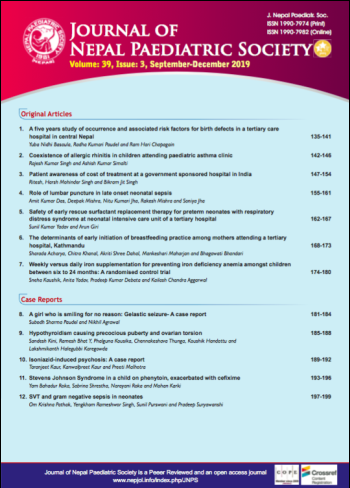A Five Years Study of Occurrence and Associated Risk Factors for Birth Defects in a Tertiary Care Hospital in Central Nepal
DOI:
https://doi.org/10.3126/jnps.v39i3.28447Keywords:
birth defect, cleft palate, live birthAbstract
Introduction: Congenital anomalies account for 7.0% of neonatal deaths in Nepal. The present study was carried out to determine the overall rate of congenital malformations, incidence and prevalence in live births, still birth and incidence affecting various organ systems, at Bharatpur Hospital, Nepal.
Methods: All the intramural deliveries between Jan 2015 to Dec 2019 were included in the study. All the newborns were looked for congenital malformations after birth within seven days. Antenatal ultrasonography findings were noted. 2D echocardiography was also used for all congenital heart diseases, along with routine X-ray chest. A total of 131 babies with congenital problem were studied and the information was recorded in WHO NBBD Proforma. Data were recorded in MS Excel and SPSS 16 version was used for analysis.
Results: Out of the total 60160 deliveries, 131 (0.21% of total birth) were with congenital malformations, sex wise distribution was 65 (49.5%) females and 63 (48.7%) males and three (1.8%) were ambiguous. Oro-facial malformation (49, 37.4%) was the commonest form of malformation followed by the musculoskeletal system (31, 23.6 %), centre nervous system (31, 23.6%) and congenital malformations of genital organs (8, 6.0%).
Conclusions: The incidence of congenital malformation in this study was 0.21%. Females were more common than males and oro-facial malformation was the commonest type of malformation. Lack of antenatal visit, lack of folic acid during pre-conception period and low socioeconomic status were the commonest risk factors.
Downloads
Downloads
Published
How to Cite
Issue
Section
License
Authors who publish with this journal agree to the following terms:
Authors retain copyright and grant the journal right of first publication with the work simultaneously licensed under a Creative Commons Attribution License that allows others to share the work with an acknowledgement of the work's authorship and initial publication in this journal.
Authors are able to enter into separate, additional contractual arrangements for the non-exclusive distribution of the journal's published version of the work (e.g., post it to an institutional repository or publish it in a book), with an acknowledgement of its initial publication in this journal.
Authors are permitted and encouraged to post their work online (e.g., in institutional repositories or on their website) prior to and during the submission process, as it can lead to productive exchanges, as well as earlier and greater citation of published work (See The Effect of Open Access).



